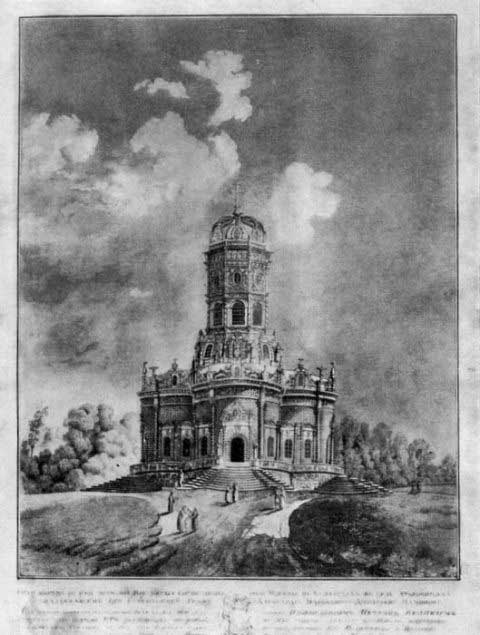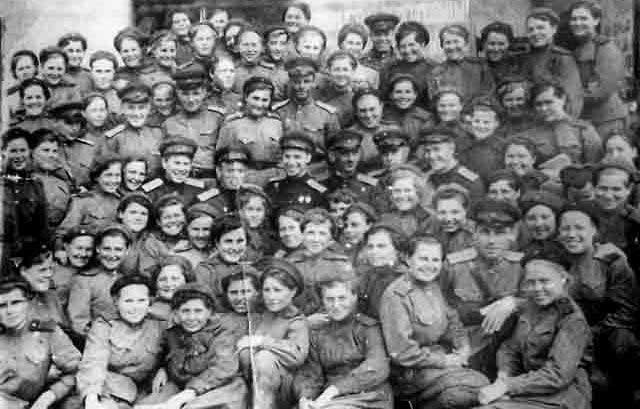History of Podolsk
17th Century
First Mention
 Although archaeological evidence suggests that the area around modern-day Podolsk has been inhabited since the iron-age, the first mention of Podolsk in documents only came about in 1627. It is recorded as the village of Podol in a census of land belonging to Moscow's Danilov Monastery. At this time Podol already had 41 peasant homesteads and a wooden church. The Dubrovitsy Estate, located in Dubrovitsy just outside of Podolsk, was also first mentioned in 1627 as the property of Ivan Morozov. After Ivan Morozov's death in 1662 the estate passed to his daughter Aksinia Morozova who married into the Golitsyn family, which led to the estate being owned by the Golitsyn family for the next hundred years. Prince Boris Golitsyn, tutor and supporter of Peter the Great, decided to build a church here and hired Western-European (possibly Italian) architects. The Our Lady of the Sign Church was consecrated in 1704 and even Peter the Great himself prayed in the new church.
Although archaeological evidence suggests that the area around modern-day Podolsk has been inhabited since the iron-age, the first mention of Podolsk in documents only came about in 1627. It is recorded as the village of Podol in a census of land belonging to Moscow's Danilov Monastery. At this time Podol already had 41 peasant homesteads and a wooden church. The Dubrovitsy Estate, located in Dubrovitsy just outside of Podolsk, was also first mentioned in 1627 as the property of Ivan Morozov. After Ivan Morozov's death in 1662 the estate passed to his daughter Aksinia Morozova who married into the Golitsyn family, which led to the estate being owned by the Golitsyn family for the next hundred years. Prince Boris Golitsyn, tutor and supporter of Peter the Great, decided to build a church here and hired Western-European (possibly Italian) architects. The Our Lady of the Sign Church was consecrated in 1704 and even Peter the Great himself prayed in the new church.
18th Century
City Status
 In 1781 Empress Catherine the Great reformed Russian administrative divisions and during such reform Podol was awarded city status and renamed Podolsk. The new city became the centre of the newly-formed Podolsk District of the Moscow Governorate. At the same time a coat of arms was designed for the city depicting two golden pick-axes on a blue background. A new regulated plan for the city was also implemented.
In 1781 Empress Catherine the Great reformed Russian administrative divisions and during such reform Podol was awarded city status and renamed Podolsk. The new city became the centre of the newly-formed Podolsk District of the Moscow Governorate. At the same time a coat of arms was designed for the city depicting two golden pick-axes on a blue background. A new regulated plan for the city was also implemented.
19th Century
Napeolonic War
In September 1812 the city was briefly occupied by French troops during Napoleon's campaign in Russia. Partisans in the area organised raids to harass the retreating French soldiers. To commemorate the liberation of the city the Trinity Cathedral was built between 1819 and 1832.
Industrial Growth
 The laying of the Varshavskoe shosse (highway) through the city in 1844 to 1847 led to the development of the city's industry and trade. In the 1860s this was further enhanced by the construction of a stone bridge crossing the River Pakhra, replacing the previous wooden bridge and before that the pontoon bridge and ferry. Finally the construction of the Moscow-Kursk Railway through the city ensured its place as a significant industrial city in the Moscow Region. In 1900, thanks to the newly improved communications, the sewing machine company Singer opened a massive factory in the city. By this time the city was already highly industrialised and had many factories, including an important cement factory.
The laying of the Varshavskoe shosse (highway) through the city in 1844 to 1847 led to the development of the city's industry and trade. In the 1860s this was further enhanced by the construction of a stone bridge crossing the River Pakhra, replacing the previous wooden bridge and before that the pontoon bridge and ferry. Finally the construction of the Moscow-Kursk Railway through the city ensured its place as a significant industrial city in the Moscow Region. In 1900, thanks to the newly improved communications, the sewing machine company Singer opened a massive factory in the city. By this time the city was already highly industrialised and had many factories, including an important cement factory.
20th Century
Second World War
 During the Second World War Podolsk found itself on the front line and was occasionally bombed by the Luftwaffe. The city's factories were converted from meeting civilian needs to providing for the military by producing ammunition and repairing tanks and other military vehicles. Later, as Podolsk looked vulnerable, several factories were evacuated east. In 1939 an artillery and infantry college was established in Podolsk. On 5 October 1941 cadets from the college joined regular troops in the Battle of Maloyaroslavets. The majority of the cadets were killed but their efforts and sacrifice bought vital time for essential additional reserves to reach Moscow. Also located in the city was the Instructor-Sniper School which had moved to Podolsk from various other locations. It ran for 27 months training hundreds of snipers, a great deal of them women.
During the Second World War Podolsk found itself on the front line and was occasionally bombed by the Luftwaffe. The city's factories were converted from meeting civilian needs to providing for the military by producing ammunition and repairing tanks and other military vehicles. Later, as Podolsk looked vulnerable, several factories were evacuated east. In 1939 an artillery and infantry college was established in Podolsk. On 5 October 1941 cadets from the college joined regular troops in the Battle of Maloyaroslavets. The majority of the cadets were killed but their efforts and sacrifice bought vital time for essential additional reserves to reach Moscow. Also located in the city was the Instructor-Sniper School which had moved to Podolsk from various other locations. It ran for 27 months training hundreds of snipers, a great deal of them women.

 History
History